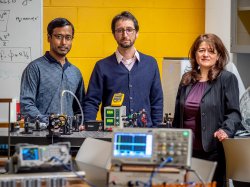Gravitational Wave Detectors restart their exploration of the Universe
Physics & Astronomy Department faculty participate in the fourth observing run of the LIGO detectors
Posted in: Physics, Science and Technology

24 May 2023 — Today the LIGO-Virgo-KAGRA (LVK) Collaboration begins a new observing run with upgraded instruments, new and even more accurate signal models, and more advanced data analysis methods. The LVK collaboration consists of scientists across the globe who use a network of observatories—LIGO in the United States, Virgo in Europe, and KAGRA in Japan—to search for gravitational waves, or ripples in space-time, generated by colliding black holes and other extreme cosmic events. Montclair State University has been a member of the LIGO Scientific Collaboration (LSC) since 2013. LIGO—the Laser Interferometer Gravitational-wave Observatory—is a pair of 4-km long laser interferometers that have observed numerous collisions involving black holes and neutron stars.
This fourth observing run, known as O4, promises to take gravitational-wave astronomy to the next level. It follows three prior observing runs, the first beginning in September 2015. Those runs have detected more than 80 black hole mergers, two probable neutron star mergers, and a few events that were most likely black holes merging with neutron stars.
O4 will begin on May 24th and last 20 months, including up to two months of commissioning breaks where the detectors will be further improved. It will be the most sensitive search yet for gravitational waves. LIGO will resume operations on May 24th, while the Virgo detector (near Pisa, Italy) will join later in the year. KAGRA—the newest detector and located under a mountain in Japan—will join for one month, beginning May 24th, rejoining later in the observing run after some upgrades. During O4, researchers expect to observe even more energetic cosmic events and gain new insights into the nature of the universe.
“We are in for a flood of gravitational wave events that will dwarf all the previous observing runs,” said Shaon Ghosh, an Assistant Professor in the Physics and Astronomy Department. “Much of the development work over the past few years has been addressing this anticipated high volume of detections, and now we are ready for the show.”

In addition to Prof. Ghosh, the Montclair State LIGO research group includes Prof. Rodica Martin, Prof. Marc Favata, and several undergraduates. The group’s research focuses on the optical components of the LIGO detectors, modeling gravitational wave signals, constraining the interiors of neutron stars, and improving our ability to find counterparts to gravitational-wave signals using optical and radio telescopes. The group members also contribute to several education and public outreach activities related to gravitational-wave science.
With the detectors’ increased sensitivity, O4 will observe a larger fraction of the universe than previous observing runs. The LIGO detectors will begin O4 approximately 30% more sensitive than before. This increased sensitivity will result in a higher rate of observed gravitational-wave signals, resulting in a detection of a merger every 2 or 3 days. Additionally, the increased sensitivity will allow us to extract more physical information (including unique astrophysical and cosmological information) from the data. It will also improve scientists’ ability to test Einstein’s theory of general relativity and infer the true population of dead stars in the local Universe.
As co-leader of a working group within the LSC, Prof. Ghosh helped spearhead the effort to send automated alerts on detected gravitational-wave signals. These software generated alerts are produced within 60 seconds of a signal detection, and are sent out to astronomers and telescope facilities around the world and orbiting in space. The alerts contain information about the possible sky position of a gravitational-wave event, allowing telescopes or space-based detectors to look for an electromagnetic signal from collisions involving neutron stars. These alerts also inform astronomers if neutron stars are involved in the coalescence and if the star’s structure is disrupted; these are crucial requirements for the emission of light following the stellar merger.
Along with undergraduate student Michael Camilo, Prof. Ghosh is also investigating how multiple detections of neutron star collisions can help constrain the interior properties of those extremely dense stars. The properties of nuclear matter at these high densities are uncertain and impossible to replicate in Earth-based laboratories; they can only be probed using neutron stars. “Our work will pave the way to systematically combine information from multiple detections and contribute to a state-of-the-art understanding of neutron star matter,” says Ghosh.
The LIGO detectors themselves underwent several upgrades since the previous observing period. Among those upgrades were improvements to various optical components that enter the LIGO detectors. Rodica Martin, an Associate Professor in the Physics & Astronomy Department, contributed to those improvements by increasing the performance of devices called Faraday isolators. These devices use magnetic fields to control the polarization of light and help constrain the path of LIGO’s powerful laser.
“The first three observing periods hinted at the enormous potential for gravitational-wave observations to probe astrophysical processes in our Universe,” says Prof. Favata, PI of the Montclair State LIGO group and chairperson of the Physics & Astronomy Department. “The significant expected increase in detected events in O4 and future observing runs will help us realize that potential.”
Gravitational-wave observatories
LIGO is funded by the NSF, and operated by Caltech and MIT, which conceived and built the project. Financial support for the Advanced LIGO project was led by NSF with Germany (Max Planck Society), the U.K. (Science and Technology Facilities Council) and Australia (Australian Research Council) making significant commitments and contributions to the project. More than 1,500 scientists from around the world participate in the effort through the LIGO Scientific Collaboration, which includes the GEO Collaboration. Additional partners are listed at http://ligo.org/partners.php .
The Virgo Collaboration is currently composed of approximately 850 members from 143 institutions in 15 different (mainly European) countries. The European Gravitational Observatory (EGO) hosts the Virgo detector near Pisa in Italy, and is funded by Centre National de la Recherche Scientifique (CNRS) in France, the Istituto Nazionale di Fisica Nucleare (INFN) in Italy, and the National Institute for Subatomic Physics (Nikhef) in the Netherlands. A list of the Virgo Collaboration groups can be found at http://public.virgo-gw.eu/the-virgo-collaboration/. More information is available on the Virgo website at https://www.virgo-gw.eu.
KAGRA is the laser interferometer with 3 km arm-length in Kamioka, Gifu, Japan. The host institute is Institute for Cosmic Ray Research (ICRR), the University of Tokyo, and the project is co-hosted by National Astronomical Observatory of Japan (NAOJ) and High Energy Accelerator Research Organization (KEK). KAGRA collaboration is composed of over 480 members from 115 institutes in 17 countries/regions. KAGRA’s information for general is at the website https://gwcenter.icrr.u-tokyo.ac.jp/en/. Resources for researchers are accessible from http://gwwiki.icrr.u-tokyo.ac.jp/JGWwiki/KAGRA.
[This article is based on the LVK news release from May 24, 2023. See https://www.ligo.org/news/images/O4start.pdf for additional details.]
